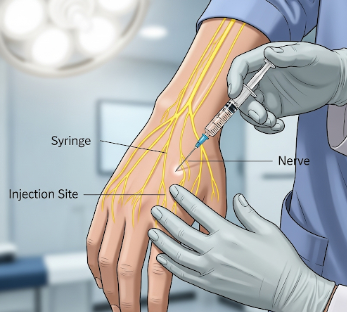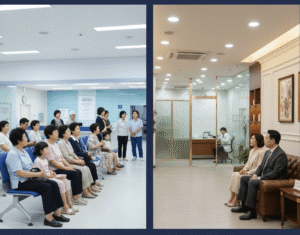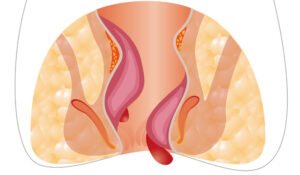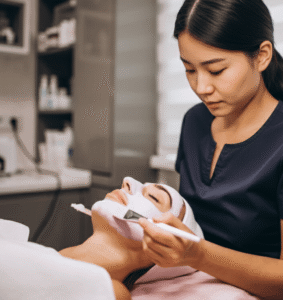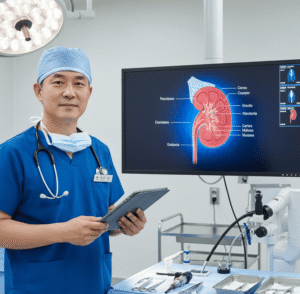Overview
Local Anesthesia is a medical technique used to numb a specific area of the body to prevent pain during minor surgical or diagnostic procedures. Unlike general anesthesia, the patient remains fully conscious and aware, while only the targeted area is anesthetized.
In Korea, local anesthesia is administered by trained anesthesiologists or healthcare professionals using safe, precise dosing and monitoring to ensure patient comfort and minimize complications.
Highlights:
- ✅ Numbs specific area without affecting consciousness
- ✅ Minimally invasive and low-risk
- ✅ Widely used in minor surgeries, dental procedures, and diagnostic interventions
What is Local Anesthesia?
Local Anesthesia involves the injection or topical application of anesthetic agents to block nerve signals in a targeted area. This prevents the brain from sensing pain in that region, allowing procedures to be performed safely and comfortably.
Indications include:
- Minor surgical procedures (skin lesion removal, biopsies)
- Dental procedures
- Minor orthopedic procedures (joint injections, tendon repairs)
- Diagnostic procedures (endoscopy, minor biopsies)
Important: The procedure allows pain-free treatment while maintaining patient consciousness, reducing recovery time and risk compared to general anesthesia.
What are the benefits?
- Pain-free procedures: Patients do not feel pain in the targeted area
- Conscious patient: Ability to communicate during procedure
- Minimal recovery time: Patients can usually leave the clinic shortly after the procedure
- Lower risk: Avoids complications associated with general anesthesia
Key benefits highlighted:
- ⚡ Safe for outpatient and minor procedures
- ⚡ Reduces systemic anesthesia risks
- ⚡ Quick onset and predictable effect
- ⚡ Can be combined with sedation if needed
Procedure Details
1) How should I prepare for Local Anesthesia?
- Pre-procedure consultation: Discuss medical history, allergies, and medications
- Medication adjustments: Certain blood thinners may need to be paused
- Fasting: Usually not required for local anesthesia alone
- Consent and education: Understand the procedure, possible side effects, and expected outcomes
- Arrange support if needed: Especially for procedures involving sedation
2) What happens during Local Anesthesia?
- Anesthetic administration: Injection, topical application, or infiltration at the surgical site
- Effect onset: Numbness occurs within minutes depending on agent and location
- Procedure performance: Surgeon or clinician performs the procedure while patient is conscious
- Monitoring: Vital signs may be monitored for safety, especially if combined with sedation
Duration: Numbing effect can last from 30 minutes to a few hours depending on the anesthetic used
3) What happens after Local Anesthesia?
- Recovery monitoring: Brief observation for allergic reactions or complications
- Pain management: Mild soreness or numbness may persist temporarily
- Activity: Normal activities can usually resume quickly; avoid trauma to the numb area
- Follow-up care: Based on the underlying procedure performed
Highlights for post-procedure care:
- ⚡ Avoid biting, scratching, or pressing on the numb area
- ⚡ Monitor for prolonged numbness, swelling, or allergic reaction
- ⚡ Resume normal activities as advised by your doctor
- ⚡ Follow specific post-procedure instructions for optimal results
Risks / Benefits
Risks:
- Mild pain or discomfort at injection site
- Temporary numbness or tingling beyond expected duration
- Rare allergic reaction to anesthetic agents
- Very rare nerve injury or systemic effects
Benefits:
- Safe, effective pain control for targeted areas
- Minimizes systemic anesthesia risks
- Allows outpatient or minor procedures to be performed efficiently
- Rapid recovery with minimal downtime
Recovery and Outlook
- Hospital stay: Usually none; performed on an outpatient basis
- Full recovery: Numbness typically resolves within a few hours
- Long-term outlook: No lasting effects from local anesthesia itself; recovery depends on underlying procedure
- Follow-up: Only required if the underlying procedure necessitates it
Tips for optimal recovery:
- ✅ Avoid trauma to the numb area until sensation returns
- ✅ Monitor for any unusual reactions or prolonged numbness
- ✅ Follow any additional instructions provided by your clinician
When To Call the Doctor
- Persistent numbness or tingling beyond expected duration
- Severe allergic reaction (rash, swelling, difficulty breathing)
- Significant pain or swelling at the injection site
- Any unexpected complications after the procedure
Best Korea Option / Process
Korea offers advanced local anesthesia care:
- Top hospitals and clinics: Experienced anesthesiologists ensure safe administration
- Wide applications: Minor surgeries, dental procedures, biopsies, and diagnostic interventions
- Safety protocols: Careful dosing, monitoring, and emergency preparedness
- International patient support: Online consultation, appointment scheduling, and follow-up guidance
Step-by-step process in Korea:
- Online consultation and review of medical history
- Pre-procedure evaluation and planning
- Local anesthesia administered by a skilled professional
- Procedure performed while monitoring patient comfort
- Post-procedure observation and discharge with instructions

